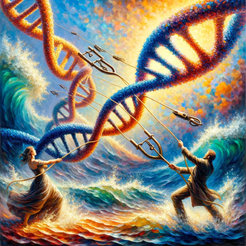Hooking an anchor on the DNA Minor Groove
Researchers at the Max Planck Institute of Biochemistry discovered a mechanism of the pioneer factor Nr5a2 that facilitates gene expression and contributes to the development of organisms.
During the reprogramming of somatic cells back into stem cells, gene regulation is controlled by pioneer transcription factors. These bind to the tightly packaged DNA in order to make it accessible. Nr5a2 is such a pioneer factor that controls the activation of the genome and initiates reprogramming in fertilized eggs. Up until now, it was not known exactly how this pioneer factor interacts with the packaged DNA. Researchers led by Kikuë Tachibana at the Max Planck Institute (MPI) of Biochemistry have now discovered that Nr5a2 can "unwind" the DNA from the histones by a novel mechanism.
The DNA of eukaryotes is compacted as chromatin, with the nucleosome representing a basic structural unit. It consists of histones around which the DNA is wrapped like a string of pearls and is therefore extremely tightly packaged. This packaging of genetic information restricts the accessibility for DNA-binding proteins such as transcription factors. To change this, specialized transcription factors, called pioneer transcription factors, can access the DNA and activate it.
Kikuë Tachibana, director at the MPI of Biochemistry and head of the Department of Totipotency, already found in a previous study that Nr5a2 is a totipotency pioneer factor that "awakens" embryonic DNA at the beginning of life. In their current study, the scientists used an imaging method, cryo-EM, to visualize how exactly Nr5a2 interacts with nucleosomes.
Wataru Kobayashi, first author of the study, created single-particle images of human Nr5a2 bound to a nucleosome, mapping its three-dimensional structure. This revealed that the DNA-binding domain of Nr5a2 competes with a DNA minor groove anchor of the nucleosome and partially unwinds the DNA from the histones. "You can imagine it as if Nr5a2 were throwing an anchor into the small turn of the DNA and pulling it away from the histones with all its might," Kobayashi illustrates the process.

“The diversity in pioneer factor mechanisms is just beginning to emerge. We found that Nr5a2 weakens DNA minor groove-histone interaction through direct competition and induces structural changes in core histones. Further structural studies are needed to understand reprogramming towards totipotency by pioneer factors,” says Kobayashi further.
Together with Karl Duderstadt and Anna Sappler, they succeeded in identifying an amino acid within Nr5a2 that is responsible for stable binding to the nucleosome and thus also for peeling off the DNA. The researchers hope that their results will provide mechanistic insights into cell reprogramming by pioneer transcription factors.
Kikuë Tachibana summarizes: “This work was made possible by the excellent scientific environment of the Max Planck Institute of Biochemistry, in particular the great collaboration with Karl Duderstadt and the strong support by the core facilities for structural biology. The findings of this study provide the molecular basis of natural and induced reprogramming by orphan nuclear receptor Nr5a2.”
[tb]
Dictionary of the Department Totipotency
Eukaryotes: Are organisms that have a nucleus in their cells.
DNA: "DNA" stands for the English term deoxyribonucleic acid and is the name for genetic information. DNA contains the "genetic code", in other words the blueprint of a living organism.
Chromatin: Chromatin is the material that makes up chromosomes. It contains our DNA, which is packaged around histones in cell nuclei.
Histones: Histones are spherical proteins
Nucleosomes: The nucleosome is the complex that the DNA forms with a histone and the basic structure unit of chromatin.
Pioneer transcription factors: A group of transcription factors that play important roles in cell differentiation and reprogramming. The precise definition of pioneer transcription factor is still debated.
Nr5a2: Nuclear receptor subfamily 5 group A member 2. One of nuclear receptor family that function pluripotent and totipotent cells. Its dysregulation is linked to gastrointestinal and pancreatic cancer.
Stem cells: Cells that have ability to develop into many different cell types.
Reprogramming: Here, reprogramming means changing or erasing epigentic marks, such as histone post-translational modifications and DNA methylation in order to re-develop somatic cells back to pluripotent cells.



